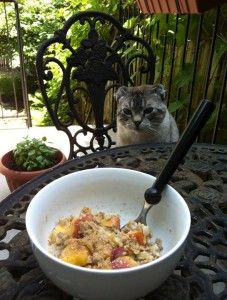I suppose that I should probably talk about how to stir up the perfect pot of porridge. Now, this is an issue of some sensitivity, bound in generations of tradition and folklore. You certainly won’t find a recipe when you open your favourite cookbook but never the less, there are thousands of variations and methods.
If you’re anything like me, the fare served up by my father on wintery saturday mornings was more reminiscent of paper-maché than of any culinary experience, leading to endless hours staring into my bowl of sludge, watching it get colder and stickier. Fortunately, my mother often took pity on our agony, and scooped up the ample leftovers to start a batch of oatmeal bread to be served hot from the oven at lunchtime. And so proceeded the oatmeal tradition of my childhood.
Until I met my husband. Who delightfully insisted that the magic ingredient was appreciation of early morning sunlight, and that two handfuls of oats per person sprinkled over your boiling water could never fail. Along with opposing thumbs, our success as a species can be attributed to having an oatmeal measuring device built into our hand size, which perfectly reflects our caloric needs for the morning. And he’s right. I’ve never seen his method fail. Despite never measuring out the amount of water to start with, his method seems to work. For him, that is. For us mere mortals, perhaps a few measurements and guidelines would be helpful.
The ratio here is different for each type of oat. We have found that when using our Naked Oats, you need almost twice as much water as oats. If you are cooking up porridge for two people, and those two people are relatively hungry sorts, 1 cup of oats and 1 3/4 cups of water should be about right. For extra specialness, you can also substitute part of the water with milk, and the resulting porridge will have a nicely rich feel to it.
Of course, if you plan on adding chopped apples with dates and flax seed, mangoes with coconut milk, dried cranberries or strawberries with vanilla and honey, fresh saskatoons or raspberries with cream, a sprinkle of raisins with cinnamon and maple syrup, bananas, peanut butter and chocolate pieces, or any other combination of toppings you can dream up, you might want to reduce your initial oat amount to make room for the accessories.
Now the essential part. After your water has come to a full boil, you need to reduce the stovetop temperature to a slow simmer, add your rolled oats and give them a bit of a stir. Many conventional large flake oats suggest needing anywhere from 7-12 minutes to cook. However, this is because the processing that they undergo (steaming, kiln drying, and steaming again) render the flakes quite brittle and dehydrated. They take a bit of extra cooking to break down. Naked oats have not been processed in any way, and so they are much quicker to absorb water and reach a nice creamy consistency. I would suggest that 5 minutes is all they will need, but the best recommendation is to watch your pot. When the flakes are looking creamy and soft, it is probably ready to eat.
This watching time is probably where the magic comes in. Don’t set a timer and rush off to find a matching pair of socks. Look out the window. Hum a little song. Add a dash of cinnamon. Wait a bit longer. This is why you chose to make a real breakfast instead of dumping factory concocted cereal in a bowl. And the satisfaction of warm porridge in your tummy as you leave the breakfast table to meet the day ahead is worth it.
So now you have made it to the end of my porridge instructions. A mere 7 paragraphs later. If by this time you’re not inspired to stir up a pot of oats, you can justify your time spent by assuring yourself that you’d still have a few chapters of Moby Dick left had you started reading it at the same time.
I’d love to hear from you. Add your porridge memories, topping suggestions, or magical ingredient by sending us a note!
For the pragmatists out there, here is the Coles notes version:
For the stovetop (one serving):
Bring 4/5 cup of water and/or milk to a boil. Add 1/2 cup Rolled Naked Oats, and reduce temperature to a simmer. Cook for 4-5 minutes, or until a nice creamy consistency is reached. Remove from heat, and add milk and toppings as desired.
Some Fun topping Suggestions:
Add a handful of chopped hazelnuts and a sprinkle of cacoa chips to your bowl.
Grated carrots and crushed pineapple added to the boiling water, and cinnamon & ginger sprinkled on top and maple syrup to sweeten
Applesauce replacing some of the water, with cinnamon, nutmeg, and hemp hearts added with the oats and a drizzle of maple syrup
Dried dates and honey with chopped almonds and cinnamon
Pumpkin puree with a wee spoonful of creamcheese, brown sugar, cinnamon and cardamom
Dried cranberries and chia seeds with honey
Pecans and cinnamon with a bit of honey. Adds crunch and tastes like pecan pie, but for breakfast!
A mushy banana with a dollop of peanut butter and a handful of chocolate chips stirred in
Fresh or frozen (Manitoba!) blueberries or saskatoons with maple syrup and almond milk
Diced apples with raisins, maple syrup, ground flax seeds, and cinnamon
Chopped mangoes with dried coconut, a splash of coconut milk, and a sprinkle of cardamom (yum!)
Turn your oatmeal into oatmeal pudding by cracking an egg into the pot just after you add the oats. Stir like mad to avoid any stringy lumps, and then add your toppings. Chopped bananas, pecans, and vanilla is pretty classic…and pretty delicious!
